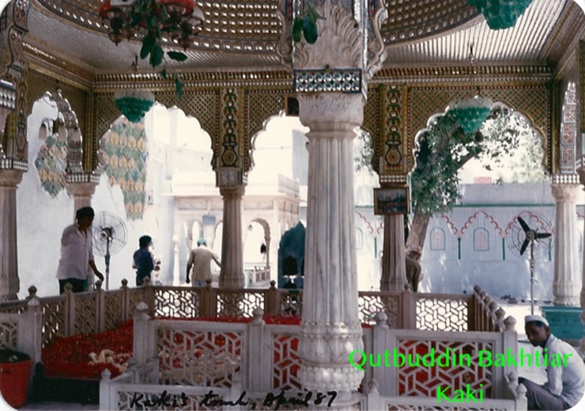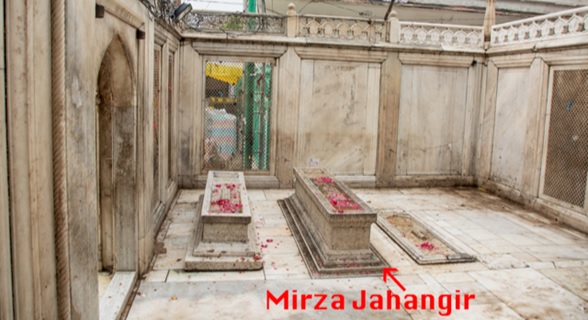

Mirza Jahangir and Phool Waloon ki Sair Festival
By Dr Khalid Siddiqui
Ohio

I visited a good number of the monuments in Delhi when I was there in 1987. Unfortunately, I was not able to take the photographs of all of them for several reasons: time constraint; rain; heat; smog; shortage of camera film; problems with recharging the batteries. etc.
Those were the early days of Camcorder. My plan was to go back better prepared in the next few years and complete the photography. But unfortunately, I couldn’t get the visa for India. Mr Raza Rumi, the well-known American/Pakistani journalist and author, introduced me to two persons in Delhi who were kind enough to obtain the required photographs for me. From time to time, I will be posting the photographs of those historical sites here along with the background information on it.
Prince Mirza Jahangir Bakht (1776-1821) was one of the fourteen sons of Mughal Emperor Akbar II (reign 1806 – 1837). He was designated the heir apparent (wali-ahad) by the Emperor under pressure from the prince’s mother, Mumtaz Mahal. However, the British Resident of the Red Fort Sir Archibald Seton, didn’t agree with his choice and forced Akbar II to nominate another son Abu Zafar (later Emperor Bahadur Shah Zafar), as his successor. This decision infuriated Prince Jahangir. He insulted Seton during an open court session. A few days later, while Archibald Seton was coming out from Darbar, Mirza Jahangir fired a shot at him from the roof of Naubat Khana or Naqqar Khana (Drum House) of the Red Fort. Seton escaped but his orderly was killed. For this act of his, Mirza Jahangir was exiled to Allahabad on the orders of Seton.
The mother of Mirza Jahangir, Queen Mumtaz Mahal Begum, was distraught and took a vow that if her son was released from Allahabad she would offer a chadar of flowers at the dargah of Khawaja Qutbuddin Bakhtiar Kaki at Mehrauli. After a couple of years, in 1812, Mirza Jahangir was released. The mood of the city was joyous after his return.
The next week Mumtaz Mahal went to Mehrauli to fulfill her vow. With her, the Imperial Court also shifted to Zafar Mahal in Mehrauli and so did the entire population of Delhi. Amidst all this merrymaking accompanied with great pomp and show, a chadar and a pankha (fan) made of flowers was offered at the dargah of Khawaja Bakhtiar Kaki. Emperor Akbar II also ordered offerings in the shape of a floral pankha at the famous Yogmaya Temple, also in Mehrauli.
Mirza Jahangir’s behavior on his return to Delhi worsened. He tried to poison the heir apparent, Bahadur Shah Zafar, twice. The British and Emperor Akbar II both agreed to send him back to Allahabad, where he was placed under house arrest. There he whiled away time drinking Hoffmann’s cherry brandy and making merry with the dancing girls.
In 1816, Governor General Warren Hastings met with him in Allahabad. He described him as “wearing a tartar dress, a crimson robe, blue vest lined with fur, and a high conical cap ornamented with jewels, though it was the peak of summer. He had long hair, cut at the side — a handsome young man gone astray.” The prince died in 1821, long before his parents. On his mother Mumtaz Mahal’s orders his body was brought to Delhi and buried near the Nizamuddin Dargah. In the Mughal tradition the sex of each tomb is marked by a simple carved symbol: a central raised ridge (representing a pen) indicates a male, and a writing slate (takhti) indicates a female.
To add insult to injury, for some strange reason, Mirza Jahangir’s tomb has a takhti carved over it! According to historian Rana Safvi this was done deliberately since he was a persona non grata with the British. (His tomb is in the middle.) In 1832/33 a fine marble mausoleum was built over it.
Seeing the response from the public and sensing the enthusiasm it generated, it was decided by Emperor Akbar II that a festival would be held annually in September/October just after the rainy season, and people from all communities will offer chadar/pankha and pankha at the dargah of Khawaja Bakhtiar Kaki and Yogmaya Temple, respectively.
To start the festivities, the people of Delhi used to march carrying a beautiful flower canopy to which flower sellers would add an intricate flower pankha at their own cost, from Chandni Chowk to Mehrauli, a distance of 11 miles, accompanied by shehnai players and dancers. Fire dancers would lead the procession with pankhas. It was named Phool Waloon ki Sair meaning ‘procession of the florists’. It was also called Sair-e-Gul Faroshan.
There were numerous baolis (step-wells) and sarais (inns) scattered along the road for the travelers, built by kings and commoners earlier. The procession would pass through Arab ki Sarai, Qutub ki Sarai, Parsi Temple ki Sarai, Yogi ki Sarai, Sheikh ki Sarai, Badli ki Sarai and Katwaria Sarai, etc. The ambience of fun and merriment was enhanced by qawwalis and kathak dances on many such rest areas.
The Darbar was also shifted to Mehrauli durng the seven days of the festival. Mughal Emperor, Akbar Shah II, used to enjoy the procession from the balcony of Zafar Mahal in Mehrauli, and watched it move towards the shrine of Khawaja Qutbuddin Bakhtiar Kaki and then to Yogmaya Temple. The flower sellers would pray for a better flower season in the coming year by offering their own big fans (pankhas), embroidered with flowers, to both the shrines.
The cultural program that followed was held in front of Jahaz Mahal at the corner of Hauz-i-Shamsi. For seven days all sorts of merrymaking continued with jhoolas (swings) in the mango groves; rooster fighting and bull baiting; kite flying, wrestling and swimming competitions; and qawwalis at night.
The festival was celebrated by both Hindus and Muslims alike. It was a demonstration of the composite culture of Delhi in an environment of communal harmony.
The festival reached its pinnacle during the reign of Bahadur Shah Zafar. He went to celebrate it even in 1857 when Delhi was under siege by the British. That was the last Phool Waloon Ki Sair under the Mughals.
The festival, however, continued to be celebrated by the British Deputy Commissioner, who was the highest government functionary in Delhi, with the help of some prominent citizens. Its celebration was disallowed by the British during the Quit India Movement of Mahatma Gandhi in 1942.
Jawaharlal Nehru revived the Festival on September 6, 1962; and all the PMs hence have participated in the festival. Indira Gandhi later requested all Indian states to participate in the festival by sending a floral pankha. Cultural troupes from different states would perform dances, drama programs and hold musical soirees (particularly qawwalis), in their colorful regional costumes at the Jahaz Mahal grounds. Hundreds would descend upon Mehrauli during this time to witness daredevil motorcycle acts, vaudeville performances, freak shows by magicians. Some events like the kushti (wrestling) competition have persisted through the decades, while others like the diving contest in the Hauz-i-Shamsi lake have been discontinued.
These days the much-shortened procession carrying floral pankhas, and led by fire dancers, starts from the Yogmaya temple, passes across Mehrauli Bazaar, and finally ends at the tomb of Khawaja Qutubuddin Bakhtiar Kaki.
The festival is organized every year by the Anjuman Sair-e-Gul Faroshan, a society registered under the Societies Registration Act. The government support, though, is waning. There used to be a half-day holiday for the schools and one day during the week for the government offices, but the government office holiday has been canceled lately. The budget for the festival too has been reduced. The government VIPs rarely show up.
The festival attracts a great number of tourists from far and wide. In 2023, it will be celebrated in September/October.
Mirza Farhatullah Baig (1883-1947), who is famous for writing the biography of Deputy Nazeer Ahmed, has also written a booklet on Phool Waloon ki Sair. An excerpt from his booklet was in my High School Urdu text book.

